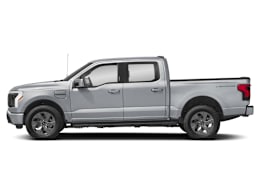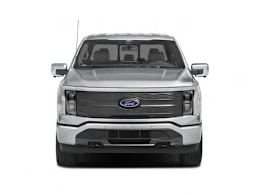The F-150 Lightning is Ford’s first fully electric pickup. In many ways it looks and feels like a regular full-sized truck, except it has blistering acceleration, a more comfortable ride than any F-150 before it, and a large front trunk. With its prodigious power and strong towing capacity, plus the added benefit of sipping electrons rather than gasoline, the F-150 Lightning is a truck for a new, greener era. The age of credible EV trucks and their smooth, quiet power has officially arrived.
The F-150 Lightning managed an impressively high road-test score compared with other pickups—including the Rivian R1T EV and the F-150 hybrid—but the Lightning’s Overall Score is hurt by the F-150’s below-average predicted reliability. And, as with any other EV, the Lightning is subject to a limited driving range and long charging times.
All Lightning trims come in a crew-cab configuration and use a dual-electric-motor setup that gives it all-wheel drive. The standard-range version is good for 452 horsepower, 775 lb.-ft. of torque, and an EPA-estimated 240-mile driving range. The optional extended-range battery that we got on our tested Lariat model increases the horsepower to 580 and the driving range to 320 miles; we saw 270 miles in our own 70-mph highway range test.
Mash the throttle pedal and the Lightning takes off with seat-pinning force, sprinting from 0 to 60 mph in just 4.3 seconds—that’s truly speedy for a pickup truck, though still a half-second slower than the ridiculously-quick R1T. And, as an EV, the Lightning delivers all that power in a smooth, linear, and whisper-quiet fashion.
Drivers can choose a “1-pedal driving mode” which maximizes regenerative braking (energy recouped from coasting and braking that goes back to the battery to potentially help range), or let the truck coast naturally as with any conventional vehicle. Either way, and unlike some other EVs, driving the Lightning requires nearly zero adjustments in driving habits or technique because the throttle pedal and regen-braking are well-calibrated. We didn’t experience the annoying abruptness when we let off the throttle that we found such a nuisance with the R1T.
It takes more than 10 hours to charge the Lightning’s huge, 131-kilowatt-hour battery at home on a 240-volt system from near-empty. Thanks to its large 19-kW on-board charger, it can benefit from quicker-than-average home charging if you’re using a hard-wired 80-amp charger on a 100-amp circuit breaker. The Lightning’s competitive, 150-kW maximum acceptance rate allows the battery to go from a 15 percent state-of-charge (SOC) to 80 percent in 44 minutes at public DC fast chargers, according to Ford. Although the Lightning is rated at a stout 10,000-pound towing capacity, hauling a heavy trailer will slash the driving range significantly.
Thanks to an independent rear suspension with coil springs (rather than the solid rear axle and leaf springs found in most pickups), the Lightning’s ride is much smoother than the regular F-150’s. The suspension also does a good job minimizing the rubbery jiggle that’s common with rugged, body-on-frame vehicles. The F-150’s slow steering and clumsy handling remain, although the Lightning turns into corners with a little more responsiveness, and the rear of the truck stays better planted over bumps. Stopping distances are a tick on the long side compared with the conventional F-150 and other full-sized trucks—that’s disconcerting, given how quickly and silently the Lightning can gain speed.
The majority of the Lightning’s cabin looks and feels very much like that of a “regular” F-150. The one big change is the giant infotainment screen that came on our tested Lariat trim. The climate controls have been integrated into the touchscreen, but it’s for worse, not better. It takes multiple steps to perform some common tasks, and the digital slider controls to adjust the climate system’s fan speed are fussy and distracting. At least the foldaway gear selector and deeply reclining front seats carry over from the regular truck. The wide and comfortable front seats suited most of our drivers well, keeping them supported on longer trips. The rear bench seat has lots of legroom but, as with other F-150s, headroom might be tight for taller occupants. The bottom cushion flips up to clear the floor for added storage.
The power-operated hood reveals a large front trunk, or “frunk,” that features a low liftover height and several handy power outlets and USB ports. The truck can even serve as a generator and power a house during an electrical outage. Kudos to Ford for providing a mobile charging kit that’s compatible with a NEMA 14-50 outlet.
Automatic emergency braking with pedestrian detection, blind spot warning, rear cross traffic warning, reverse automatic emergency braking, lane departure warning, lane keeping assistance, and automatic high beams come standard. Ford’s BlueCruise active driving assistance feature—which allows for limited hands-free highway driving—is available on the third-tier Lariat and standard on the top Platinum trim. BlueCruise combines adaptive cruise control, lane centering assistance, and direct driver monitoring via an infrared camera.


























